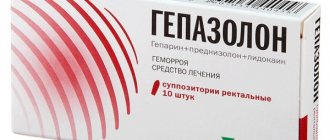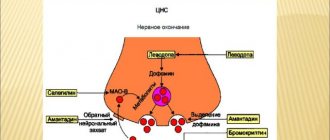Release form and composition
Dosage form – coated tablets: oval, with a separating line on one side and marked “717” on the other, yellow (7 or 14 pieces in blisters, 1 or 2 blisters in a cardboard box).
Content of active ingredients in 1 tablet:
- Losartan potassium – 50 mg;
- Hydrochlorothiazide – 12.5 mg.
Excipients: pregelatinized starch 1500, aqueous lactose (spray dried), magnesium stearate, microcrystalline cellulose (Avicel PH102).
Shell composition: hydroxypropyl methylcellulose (6 cps), hydroxypropyl cellulose (with less than 0.3% silicon), carnauba wax, quinoline yellow aluminum varnish (E104), titanium dioxide (E171).
Brief information about the drug
Release form
The medicine is released in tablet form. Oval tablets are coated with a yellow film coating. Each tablet is stored in a blister cell. In total, the package contains 14 or 28 tablets. The kit includes instructions for using Gizaar.
Active substance
Gizaar contains two main components: losartan and hydrochlorothiazide.
Other components:
- MCC;
- lactobiose;
- corn starch;
- magnesium stearate;
- food additive E463;
- titanium dioxide;
- food additive E104 yellow;
- wax.
Packaging of Gizaar tablets
pharmachologic effect
The tablets have a diuretic and antihypertensive effect.
Manufacturer
The tablets are manufactured by Merck Sharp & Dohme BV in the Netherlands.
Storage conditions and periods
The drug should be stored out of the reach of children. The recommended storage temperature should not be lower than 15%.
The shelf life of the medicine is 3 years. After the expiration date, the tablets cannot be used.
Conditions for dispensing from a pharmacy
The drug is available only with a prescription.
Price
Tablets cost from 350 to 1000 rubles per pack; the price of Gizaar tablets depends on the quantity and dosage.
Pharmacodynamics and pharmacokinetics
The active substances of Gizaar - losartan and hydrochlorothiazide - are characterized by an additive hypertensive effect, since they reduce blood pressure (BP) more significantly than each of the components separately. It is believed that this effect is caused by the complementary action of both components of the drug. Hydrochlorothiazide has a diuretic effect, which leads to a decrease in the concentration of potassium in the blood serum, an increase in plasma renin activity (PRA), an increase in the content of angiotensin II and stimulation of aldosterone production.
The use of losartan suppresses all physiological effects of angiotensin II and, by reducing the effects of aldosterone, may help reduce diuretic-induced potassium losses. Losartan is also characterized by a moderate and transient uricosuric effect. Hydrochlorothiazide causes a slight increase in uric acid levels in the blood. Combining it with losartan can reduce the severity of symptoms of hyperuricemia, which was caused by taking a diuretic.
Losartan selectively binds to AT1 receptors, without leading to binding and blocking the receptors of other hormones and ion channels responsible for regulating the functions of the cardiovascular system. Also, losartan is not an inhibitor of angiotensin-converting enzyme (ACE, kininase II), which causes the destruction of bradykinin. For this reason, the effect of losartan on the body does not enhance bradykinin-mediated effects or the occurrence of edema.
The mechanism of the antihypertensive effect of thiazides has not yet been studied. Typically, these compounds do not affect normal blood pressure readings.
Hydrochlorothiazide belongs to the group of diuretics and antihypertensive drugs. It affects the reabsorption of electrolytes in the distal tubules of the kidneys. Hydrochlorothiazide approximately equally increases the excretion of chloride and sodium ions. Natriuresis is sometimes accompanied by small losses of bicarbonate and potassium ions. When taken orally, the diuretic effect appears within 2 hours, reaches its maximum value after 4 hours and lasts 6–12 hours.
In patients with left ventricular hypertrophy and arterial hypertension, losartan, including in combination with hydrochlorothiazide, reduces the risk of cardiovascular disease and mortality.
Losartan prevents the increase in systolic and diastolic blood pressure during angiotensin II infusion. When the maximum content of losartan in the blood plasma is reached after taking Gizaar at a dose of 100 mg, the effect of angiotensin II described above is suppressed by approximately 85%, and a day after single and multiple doses - by 26–39%.
Losartan does not affect autonomic reflexes and does not change the concentration of norepinephrine in the blood plasma over a long period of time.
When taken orally, losartan is well absorbed and metabolized during the first pass through the liver, where it forms an active carboxylated metabolite and inactive metabolites. The systemic bioavailability of this compound in tablet form is about 33%. Average maximum concentrations of losartan and its metabolic products are recorded after 1 hour and after 3 hours, respectively. When taking Gizaar with food, no clinically significant changes in the content of losartan in the blood plasma were detected.
Losartan and its active metabolite are able to bind to plasma proteins (mainly albumin) by at least 99%. Hydrochlorothiazide penetrates the placental barrier (the blood-brain barrier is inaccessible to it) and is excreted in breast milk.
Plasma clearance of losartan and its active metabolite is approximately 600 and 50 ml/min, respectively. The renal clearance of the above compounds is approximately 74 and 26 ml/min, respectively. When losartan is taken orally, approximately 4% of the dose is excreted unchanged through the kidneys and approximately 6% of the dose is excreted as an active metabolite. After oral administration, plasma concentrations of losartan and its active metabolite decrease polyexponentially, with a terminal half-life of about 2 and 6–9 hours, respectively.
When taking Gizaar at a dosage of 100 mg 1 time per day, there is no significant accumulation of either losartan or its active metabolite in the blood plasma. These substances are excreted through the kidneys and through the intestines with bile.
Hydrochlorothiazide is not metabolized and is excreted through the kidneys at a significant rate. Monitoring the content of the substance in the blood plasma for 24 hours showed that its half-life is 5.6–14.8 hours. At least 61% of the dose taken orally is excreted in its original form within one day.
When Gizaar was taken orally by patients with mild and moderate alcoholic cirrhosis, the content of losartan and its active metabolite in the blood plasma was 5 and 1.7 times higher than standard values, respectively.
Use of the drug Gizaar forte
Gizaar Forte is taken regardless of meals. The drug can be prescribed in combination with other antihypertensive drugs. AH (arterial hypertension) The usual initial and maintenance dose of Gizaar is 50/12.5 mg (1 tablet 1 time per day). In patients without a therapeutic effect when taking 1 tablet of Gizaar (50/12.5 mg) for 2–4 weeks, the dose of the drug can be increased to 2 tablets of Gizaar (50/12.5 mg) or 1 tablet of Gizaar Forte (100/12 .5 mg) 1 time per day. The maximum dose is 2 tablets of Gizaar 50/12.5 mg or 1 tablet of Gizaar Forte 100/12.5 mg 1 time per day. As a rule, the hypotensive effect is achieved within 3 weeks after the start of treatment. Selection of the initial dose of the drug - 1 tablet of Gizaar containing 50/12.5 mg - is not required in elderly patients. In elderly patients, Gizaar should not be used as initial therapy at a dose of 2 tablets of 50/12.5 mg or 1 tablet of 100/12.5 mg. Reducing the risk of cardiovascular complications and mortality in patients with hypertension (arterial hypertension) and hypertrophy left ventricle The standard initial dose of losartan is 50 mg 1 time per day. In patients who fail to achieve the target blood pressure level when taking losartan at a dose of 50 mg / day, a combination of losartan and low doses of hydrochlorothiazide (12.5 mg) should be used and, if necessary, the dose of losartan should be increased to 100 mg / day in combination with hydrochlorothiazide at a dose of 12.5 mg/day (1 tablet of Gizaar Forte), then increase the dose to 2 tablets of Gizaar (50 mg/12.5 mg) once a day (total 100 mg of losartan and 25 mg of hydrochlorothiazide). The duration of treatment is determined individually.
Contraindications
- Age up to 18 years;
- Severe liver dysfunction;
- Severe renal impairment (creatinine clearance (CC) less than 30 ml/min);
- Anuria;
- Glucose-galactose malabsorption syndrome, lactose intolerance, lactase deficiency;
- Pregnancy and breastfeeding period;
- Hypersensitivity to sulfonamide derivatives and/or components of the drug.
It is recommended to prescribe Gizaar with caution to patients with renal failure (creatinine clearance 30-50 ml/min), stenosis of the artery of a single kidney, bilateral stenosis of the renal arteries, disturbances in the water-electrolyte balance of the blood (including those caused by vomiting or diarrhea (hyponatremia, hypochloremic alkalosis, hypomagnesemia , hypokalemia)), gout, hypercalcemia, hyperuricemia, diabetes mellitus, bronchial asthma and a burdened allergic history, hypovolemia (including while taking high doses of diuretics), systemic connective tissue diseases (including systemic lupus erythematosus); while taking non-steroidal anti-inflammatory drugs, including cyclooxygenase (COX)-2 inhibitors.
Side effects
In clinical studies, the most frequently observed adverse reactions were weakness, dizziness, and fatigue.
Post-marketing experience with the drug has identified additional side effects:
- Digestive system: rarely – diarrhea, hepatitis;
- Immunopathological and allergic reactions: anaphylactic reactions, swelling of the larynx and glottis with the development of airway obstruction or other symptoms of angioedema, including swelling of the face, lips, tongue and/or pharynx; rarely – vasculitis (Henoch-Schönlein purpura);
- Dermatological reactions: urticaria, increased photo- and photosensitivity;
- Respiratory system: possible – cough;
- Laboratory indicators: rarely - slight hyperkalemia (does not require discontinuation of the drug), a transient increase in alanine aminotransferase activity.
special instructions
The use of Gizaar in combination with other antihypertensive drugs is indicated.
The effect of drugs on the renin-angiotensin system may increase creatinine and urea levels in the blood in patients with bilateral renal artery stenosis or arterial stenosis of a solitary kidney.
The presence of losartan suppresses the function of the renin-angiotensin system and may cause changes in renal function and renal failure. The changes are reversible and disappear after discontinuation of the drug.
While taking the drug, patients may develop symptomatic arterial hypotension.
Treatment should be accompanied by regular monitoring of water and electrolyte balance, which will allow timely identification of clinical signs of hyponatremia, dehydration, hypochloremic alkalosis, hypokalemia, hypomagnesemia. Serum electrolyte levels should be checked in case of vomiting or intercurrent diarrhea.
According to the instructions, Gizaar may impair glucose tolerance, so some patients may need to adjust the dose of insulin and other hypoglycemic agents.
Thiazides may cause slight and occasional increases in serum calcium concentrations and reduce urinary calcium excretion. Severe hypercalcemia may indicate latent hyperparathyroidism.
Since the effect of thiazides on calcium metabolism may distort parathyroid function tests, the thiazide diuretic should be discontinued before testing.
During therapy with thiazide diuretics, the content of triglycerides and cholesterol in the blood may increase, a hypersensitivity reaction may develop, and systemic lupus erythematosus may progress or worsen.
The combined composition of the drug can reduce the severity of hyperuricemia and/or the risk of developing gout, since losartan reduces the level of uric acid.
Pharmacodynamics: mechanism of action on blood pressure
The combination type drug belongs to the pharmacological class of diuretics with a synergistic hypotensive effect. Hyzaar reduces blood pressure with losartan by blocking the production of angiotensin 2 receptors. Hydrochlorothiazide has a diuretic effect.
The drug belongs to the group of angiotensin 2 receptor antagonists
The drug reduces urate levels, reduces the likelihood of developing heart and vascular diseases, and reduces mortality due to cardiac abnormalities.
The diuretic effect appears 2 hours after taking the tablet. The maximum hypotensive effect is noticeable after 4 hours. The effect of one tablet lasts for 6-12 hours.
Drug interactions
Combining the drug with potassium-sparing diuretics, including spironolactone, triamterene, amiloride, potassium salts or potassium-containing supplements, may help increase serum potassium concentrations.
The therapeutic effect of the drug may be reduced when combined with non-steroidal anti-inflammatory drugs.
Concomitant use with ethanol, barbiturates, and opioid analgesics may increase the risk of orthostatic arterial hypotension.
When combined with other antihypertensive drugs, an additive effect occurs.
The absorption of hydrochlorothiazide is disrupted by the presence of anion exchange resins. When taking cholestyramine or colestipol simultaneously, the absorption of hydrochlorothiazide is significantly reduced.
The use of Gizaar with adrenocorticotropin and corticosteroids leads to a strong decrease in electrolyte levels and hypokalemia.
The drug enhances the effect of tubocurarine and other muscle relaxants of a non-depolarizing type of action.
Combination with lithium preparations is not recommended, since it leads to a decrease in the renal clearance of lithium and increases the risk of developing its toxic effect.
Overdose of the drug Gizaar forte, symptoms and treatment
Losartan The most likely symptoms of overdose are hypotension and tachycardia; bradycardia may result from parasympathetic (vagal) stimulation. In case of symptomatic arterial hypotension, maintenance therapy is indicated. Losartan and its active metabolite are not eliminated by hemodialysis. Hydrochlorothiazide The most common symptoms of overdose are electrolyte deficiency (hypokalemia, hypochloremia, hyponatremia) and dehydration due to increased diuresis. When taking cardiac glycosides simultaneously, hypokalemia may cause increased arrhythmia. Hydrochlorothiazide is eliminated by hemodialysis, although the extent of elimination has not been established. There is no data on specific treatment for overdose of Gizaar Forte. Treatment is symptomatic and supportive. Therapy with Gizaar Forte should be discontinued and the patient should be monitored. Possible therapeutic measures include inducing vomiting in the case of recent use of the drug, as well as correction of dehydration, electrolyte disturbances, hepatic coma and hypotension using symptomatic therapy.


